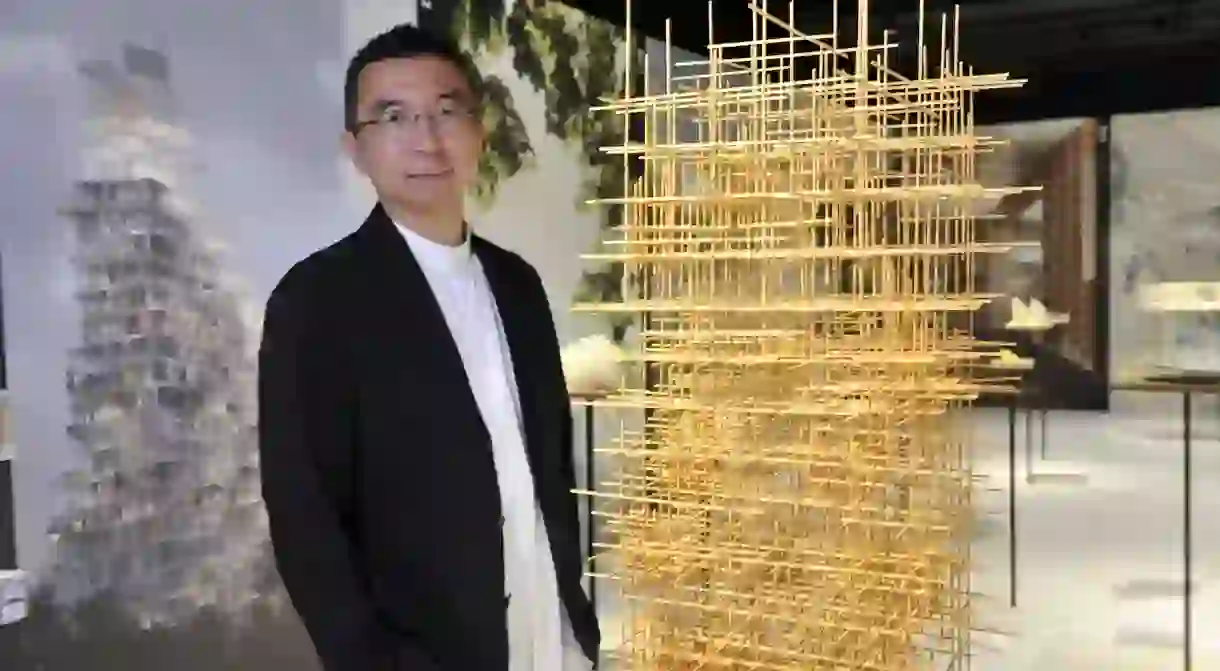See The Innovative Architecture of Sou Fujimoto at Japan House

Japan House in London launches with an exhibition about the innovative and visionary Japanese architect Sou Fujimoto. Here, we take a closer look at the architect’s international projects.
Probably best known for his 2013 Serpentine Pavilion, which welcomed visitors of all ages into a see-through cloud-like structure, Fujimoto has been creating innovative architectural projects the world over. Inspired by our connection to nature and the fluidity of inhabited space, a recurrent theme in Fujimoto’s practice is the dialogue of inside and outside, transparency and opacity. From his Final Wooden House (2008) in Japan to his recent apartment block L’Arbre Blanc (2017) in Montpellier, the Japanese architect creates magnificent spaces where architectural and organic order can coexist.
The inaugural exhibition at the recently opened Japan House in Kensington, London, is dedicated to the architect’s experimental approach. Sou Fujimoto: Futures of the Future features a number of maquettes, beautifully presented on simple plinths, to show the concept process for both completed and unrealised projects. Among the miniature buildings, there are even unexpected paraphernalia including a fake flower, netting and scrunched up paper, all of which have inspired Fujimoto’s designs.
Here, we’ve chosen a number of projects outlined in the show which are explained in Fujimoto’s own words.

House NA in Tokyo, 2011
Can we not state that architecture is a field where the transparent and the opaque are intricately woven together, and furthermore, that the quintessential place where opacity and transparency are vividly interspersed is the forest? Under such a premise, I imagine that ultimately architecture will evolve to be something like a forest. Here, although the house is composed of white box from with rectangular openings of an artificial order, the effervescent layers endow the space with an amorphous and organic richness.

Forest of Music in Budapest, 2014
As the site was situated in a forest inside the park, I envisioned an archetypal landscape of someone performing music among the trees. I created a space that was open to the surrounding forest but was also protected from the weather. The roof is filled with numerous skylights, allowing light to seep in like sunbeams streaming through trees. As the building is surrounded by trees, its exterior is almost completely invisible. The gradual change from nature to building gives rise to a new architectural experience.

L’Arbre Blanc (The White Tree) in Montpellier, 2017
In this city [Montpellier] with a Mediterranean climate, it is warm enough to eat outside even in the winter, so the local residents spend a lot of time on their balconies and outdoor terraces. The new typology I proposed in this plan, calling for an over 50-meter-high building, was inspired by this type of climate and lifestyle. The idea is extremely simple. Countless, huge balconies extend from the 17-floor apartment building. The structure is linked to a riverside greenbelt, and I did my best to block the sight light from surrounding buildings while giving the volume an organic form. The hundreds of balconies combine with the curved form of the structure, giving the overall building a distinctive appearance, like a huge tree.

Serpentine Pavilion in London, 2013
In many different ways, this project is a culmination of the essence of my architecture. The structure, made of a grid lattice of 2cm² steel pipes, is a proposal for a place transcending the natural and artificial. The interiors and exteriors subtly trade places with each other, the transparent and opaque qualities are constantly changing due to the layered structure. The 40cm grid functions as a bench and also at times as a staircase, creating a variety of places where people can relax. There is a striking harmony between simplicity and complexity. It is a rediscovery of all the basics of architecture. This work is certain to be an archetype for new architecture in the contemporary age.

Musashino Art University Museum & Library in Tokyo, 2010
I think a library is a place akin to a forest. People drift through the space in both intentional and fortuitous wanderings, eventually discovering things beyond their comprehension. On the one hand, there is the notion of searchability, a systemic form allowing one to search and find one’s intended book, and on the other hand there is strollability, meandering through the space, stimulated by thoughts that eventually lead one to unexpected discoveries. A library is a place where these two apparent contradictions are allowed to coexist. Searchability desires for systematic order, and strollability desires for multifarious order like a forest. This is a contradistinction between nature and artificiality, order and chaos, triviality and immensity, simplicity ad complexity. Considered in this light, a library is in itself an analogy of architecture, and perhaps of the constructed spatial world. Could this be what Borges implied in his literature?

Sou Fujimoto: Futures of the Future is at Japan House, 101-111 Kensington High Street, London, W8 5SA until August 5, 2018.
Want to see more art in London? Here are the best free exhibitions to see this week.













